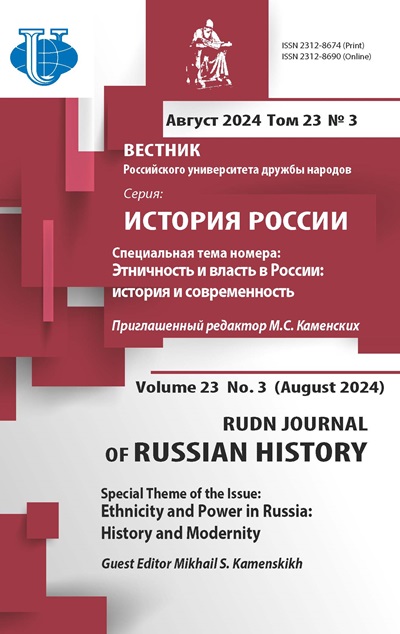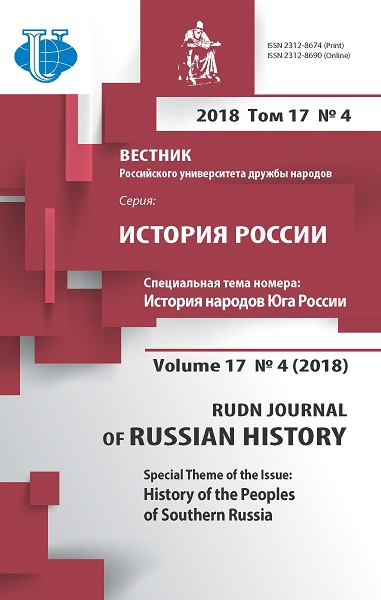Ethno-political situation in the Oka estuary region on the eve of the Mongol invasion
- Authors: Kuznetsov A.A1
-
Affiliations:
- Lobachevsky State University of Nizhny Novgorod
- Issue: Vol 17, No 4 (2018): HISTORY OF THE PEOPLES OF SOUTHERN RUSSIA
- Pages: 863-889
- Section: ARTICLES
- URL: https://journals.rudn.ru/russian-history/article/view/19833
- DOI: https://doi.org/10.22363/2312-8674-2018-17-4-863-889
Cite item
Full text / tables, figures
Abstract
The article is devoted to the ethno-political situation in the region of the Oka estuary up to 1238. In 1221 Nizhny Novgorod was founded in this region. The forthcoming 800th anniversary of the city lends particular social and cultural relevance to the present study; these aspects of the history of Eastern Europe and North-Eastern Russia are considered here for the first time. The research is based on the study of chronicles and narratives from the 17th to 19th centuries, as well as of toponyms. The source corpus is represented here by the Lavrentyevskaya chronicle, the Ipatyevskaya chronicle, the Simeonovskaya chronicle, the Tolkovaya Paleya, as well as the “Slovo o pogibeli russkoi zemli” (“The word about the death of the Russian land”), in addition to results of archaeological and toponymic research. The author offers a novel interpretation of the Cheremis-Meshcher group in the region of the Oka estuary, by demonstrating that these Cheremis lived between the rivers Volga, Oka and Klyazma; these Cheremis has no direct relation to the Mari. The article presents arguments in favor of the hypothesis that before 1221 there had been no Slavic population in the Oka estuary. The assumption that Brodniks were living in this region cannot be confirmed. There are not enough representative sources to interpret the occurrence of the term Purgasova Rus ’ . The Mordvins lived far from the Oka estuary. Polovtsy (Cumans), however, were present in the region. This territory remained beyond the political influence zone of Volga Bolgaria. Accordingly, it must be accepted that Nizhny Novgorod was founded on an uninhabited place. The area around Nizhny Novgorod was a frontier zone where the interests of Volga Bolgaria clashed with those of the Vladimir Principality. The foundation of Nizhny Novgorod changed the nature of the conflict in this frontier. The Cheremis were blocked, and a military-diplomatic offensive was launched on the Mordvins. The Polovtsy (Cumans) acted as allies of the Vladimir Principality, and the latter was victorious in the Russian-Bolgarian war of 1223-1230. The reconstruction of the complex ethno-political situation in the region of the Oka estuary enables us to study the imperial practices of the princes of Vladimir before the Mongol invasion.
About the authors
Andrey A Kuznetsov
Lobachevsky State University of Nizhny Novgorod
Author for correspondence.
Email: nalbuz@mail.ru
-
27 Lenin Av., Nizhny Novgorod, 603140, RussiaReferences
- Ageeva, R.A. Strany i narody: Proishozhdenie nazvanii [Countries and peoples: Origin of names]. Moscow: Nauka Publ., 1990 (in Russian).
- Anikin, I.S. “Ob etnicheskoi prinadlezhnosti kurgannyh pogrebenii srednevekovoi mordvy (po materialam Sarleiskogo mogil’nika).” In Povolzhskie fi nny i ih sosedi v epohu Srednevekov’ya [“On the ethnicity of the burial mounds of the medieval Mordovians (based on the materials of the Sarlai burial ground)]. Saransk: [S.n.], 2000 (in Russian).
- Maureen, Perry, ed. From Early Rus’ to 1689. Vol. 1 of The Cambridge history of Russia. N.p.: Cambridge University Press, 2006.
- Chernetsov, A.V. “K probleme istoricheskogo znacheniya mongolo-tatarskogo nashestviya kak istoricheskogo rubezha.” [The problem of evaluation of historic signifi cance of the Mongol-Tatar invasion as chronological marker] In Rus’ v XIII veke: Drevnosti temnogo vremeni, 12–17. Moscow: Nauka Publ., 2003 (in Russian).
- Drevnyaya Rus’ v srednevekovom mire: enciklopediya [Old Rus’ in the medieval world: an encyclopedia]. Moscow: Ladomir Publ., 2014 (in Russian).
- “Evreisko-hazarskaya perepiska o narodah Hazarii. Otvetnoe pis’mo tsarya Iosifa (prostrannaya redakciya).” [Jewish-Khazar correspondence about the peoples of Khazaria. A response letter to king Joseph (extensive edition)] In Petruhin, V.Ya., and Raevskii, D.S. Ocherki istorii narodov Rossii v drevnosti i rannem srednevekov’e, 352–353 Moscow: Yazyki russkoi kul’tury Publ., 1998 (in Russian).
- Fennel, J. Krizis srednevekovoi Rusi. 1200–1304 [The Crisis of Medieval Russia 1200−1304]. Moscow: Progress, 1989 (in Russian).
- Finno-ugry i balty v epohu srednevekov’ya [Finno-Ugric and Baltic in the middle ages.] Moscow: Nauka Publ., 1987 (in Russian).
- Fomin, V.V. “Purgasova Rus’.” [The Rus’of Purgas]. Voprosy istorii, no 9 (2007): 3–17 (in Russian).
- Franklin, S., and Shepard, J. Nachalo Rusi. 750−1200 [The Emergence of Rus: 750–1200]. St-Petersburg: Dmitrii Bulanin Publ., 2000.
- Gatsiskii, A.S. “Nizhegorodka.” In Gatsiskii A.S. Nizhegorodskii letopisec. Nizhni Novgorod: [S.n.], 2001 (in Russian).
- Golubeva, L.A. “Mariicy.” [Maris] In Finno-ugry i balty v epohu srednevekov’ya, 107–115. Moscow: Nauka Publ., 1987 (in Russian).
- Gribov, N.N. Nizhni Novgorod v XV veke: poiski utrachennogo goroda [Nizhny Novgorod in the XV century: search of lost city]. Moscow: IA RAN Publ., 2018 (in Russian).
- Gribov, N.N., and Lapshin, V.A. “Nizhegorodskii kreml’ v XIII–XIV i XV vekah.” [Nizhni Novgorod Kremlin in XIII–XIV and XV centuries] Arheologicheskie vesti, no. 15 (2008): 141–156 (in Russian).
- Hramtsovskii, N.I. Kratkii ocherk istorii i opisanie Nizhnego Novgoroda [A short essay on the history and description of Nizhny Novgorod]. Nizhni Novgorod: Nizhegorodskaya yarmarka Publ., 1998 (in Russian).
- Polnoe sobranie russkih lettopisey [Complete collection of Russian annals]. Vols. 1−5, 15, 25, 42. Moscow: Yazyki russkoi kul’tury, 1997−2002 (in Russian).
- Polnoe sobranie russkih lettopisey [Complete collection of Russian annals]. Vol. 18. Moscow: Znak Publ., 2007 (in Russian).
- Polnoe sobranie russkih lettopisey [Complete collection of Russian annals], 37–85. Vol. 26. Moscow: Rukopisnye pamyatniki Drevnei Rusi Publ., 2006 (in Russian).
- Kappeler, Andreas. “The Russian Southern and Eastern Frontiers from the 15th to the 18th Centuries.” Ab Imperio, no. 1 (2003): 47−49 (in Russian).
- Kuznetsov, A.A. “Abramov gorodok, Staryi gorodok na Dyatlovyh gorah: onomasticheskie aspekty razvitiya narrativa o predshestvennike Nizhnego Novgoroda.” [Abramov gorodok, Staryi gorodok na Dyatlovyh gorah: onomastic aspects of the development
- of the narrative about the predecessor of Nizhni Novgorod] In Nizhegorodskie issledovaniya po kraevedeniyu i arheologii: sbornik nauchnyh i metodicheskih statei, 68–80. Nizhni Novgorod: Pixel-print Publ., 2016 (in Russian).
- Kuznetsov, A.A. Knyaz’ velikii Georgii – osnovatel’ Nizhnego Novgoroda [Prince George the great is founder of Nizhny Novgorod]. Nizhni Novgorod: Dekom Publ., 2017 (in Russian).
- Kuznetsov, A.A. Vladimirskii knyaz’ Georgii Vsevolodovich v istorii Rusi pervoi treti XIII v. Osobennosti prelomleniya istochnikov v istoriografi i [Prince of Vladimir, Georgy Vsevolodovich in the history of Russia of the fi rst third of the 13th century, features of the refractive index of sources in the historiography]. Nizhny Novgorod: Nizhegorodskiy gosuniversitet Publ., 2006 (in Russian).
- Kuchkin, V.A. Formirovanie gosudarstvennoi territorii Severo-Vostochnoi Rusi v X−XIV vv. [Formation of the state territory of North-Eastern Russia in the 10th–14th centuries]. Moscow: Nauka Publ., 1984 (in Russian).
- Kuchkin, V.A. Volgo-Okskoe mezhdurech’e i Nizhny Novgorod v srednie veka [Volga-Oka interfl uve and Nizhny Novgorod in the middle ages]. Nizhni Novgorod: Kvarc Publ., 2011 (in Russian).
- Mel’nikov, P.I. “Ocherki mordvy.” [“Essays on the Mordvins”] In Polnoe sobranie sochinenii P.I. Mel’nikova. Vol. 7. Moscow; St-Petersburg, 1909 (in Russian).
- Nasonov, A.N. Russkaya zemlya” i obrazovanie territorii Drevnerusskogo gosudarstva. Mongoly i Rus’ [Russian land “and the formation of the territory of the Old Russian state. The Mongols and Russia]. St-Petersburg: Nauka Publ., 2006 (in Russian).
- Nikitina, T.B., Arhipov, G.A., and Sepeev, G.A. “Problema proishozhdeniya mari.” [The problem of the origin of the Mari] In Narody Povolzh’ya i Priural’ya. Komizyryane. Komi-permyaki. Mariicy. Mordva. Udmurty, 187–190. Moscow: Nauka Publ., 2000 (in Russian).
- Shaidakova, M.S. Nizhegorodskie letopisnye pamyatniki XVII v. Nizhni Novgorod: Nizhegorodskiy gosuniversitet Publ., 2006 (in Russian).
- Pashuto, V.T. Vneshnyaya politika Drevney Rusi [Foreign Policy of Ancient Russia]. Moscow: Nauka Publ., 1968 (in Russian).
- Petruhin, V.Ya. “Finskie plemena i prizvanie varyagov.” [Finnish tribes and the calling of Vikings] In Vostochnaya Evropa v drevnosti i srednevekov’e. Migracii, rasselenie, voina kak faktory politogeneza, 212–214. Moscow: IVI RAN Publ., 2012 (in Russian).
- Petruhin, V.Ya., and Raevskii, D.S. Ocherki istorii narodov Rossii v drevnosti i rannem srednevekov’e [Essays on the history of the peoples of Russia in antiquity and the early Middle Ages]. Moscow: Yazyki russkoi kul’tury Publ., 1998 (in Russian).
- Pudalov, B.M. Nachal’nyy period istorii drevneishih russkih gorodov Srednego Povolzh’ya (XII – pervaya tret’ XIII v.) [The initial period of the history of the most ancient Russian cities of the Middle Volga region (12th-fi rst third of the 13th century)]. Nizhni Novgorod: Komitet po delam arhivov Administracii Gubernatora Nizhegorodskoi oblasti Publ., 2003 (in Russian).
- Riber, A. “Menyayushiesya koncepcii i konstrukcii frontira: sravnitel’no-istoricheskii podhod.” [Changing Concepts and Constructions of Frontiers: A Comparative Historical Approach] In Novaya imperskaya istoriya postsovetskogo prostranstva: Sbornik statei (Biblioteka zhurnala «Ab Imperio). Kazan, 2004 (in Russian).
- Ryabinin, E.A. “Cheremis.” In Drevnyaya Rus’ v srednevekovom mire: enciklopediya, 873. Moscow: Ladomir Publ., 2014 (in Russian).
- Ryabinin, E.A. “Meshchera.” In Drevnyaya Rus’ v srednevekovom mire: enciklopediya, 488. Moscow: Ladomir Publ., 2014 (in Russian).
- Ryabinin, E.A., and Kuznecova, V.N. “Muroma.” Drevnyaya Rus’ v srednevekovom mire: enciklopediya, 529–530. Moscow: Ladomir Publ., 2014 (in Russian).
- “Slovo o pogibeli Russkoi zemli.” [A word about the death of the Russian land] In Biblioteka literatury Drevnei Rusi, 90−91. Vol. 5. St-Petersburg: Nauka Publ., 1997 (in Russian).
- Solov’ev, A.V. “Gorodenskie knyaz’ya i Deremela (k tolkovaniyu “Slova o polku Igoreve”).” [Gorodensky princes and Deremel (to the interpretation of “The Lay of Igor’s Host”)] In Russia Mediaevalis, 69–80. Vol. 7, part 1. München: [S.n.], 1992 (in Russian).
- Tatisсhev, Vasiliy N. Istoriya Rossiiskaya [History of Russia]. Vols. 3−4. Moscow; Leningrad: Nauka Publ., 1964 (in Russian).
- Vilkul, Tat’yana. “Tolkova Paleya i Povest’ vremennyh let. Syuzhet o ‘razdelenii yazyk’.” [Tolkova Palea and the Tale of Bygone Years. The plot of the ‘division of language’] In RUTHENICA, 37–85. Vol. 6. Kiev, 2007 (in Russian).
- Voronin, I.D. “K voprosu o mordovskoi toponimike.” [On the question of Mordvinian toponymy] In Zapiski NII pri Sovete Ministrov Mordovskoi ASSR, 281–282. Saransk, 1951: (in Russian).
- Gosudarstvenniy obshestvenno-politicheskii arhiv Nizhegorodskoi oblasti [State sociopolitical archive of Nizhny Novgorod region], f. 7875, op. 2, d. 76.
















